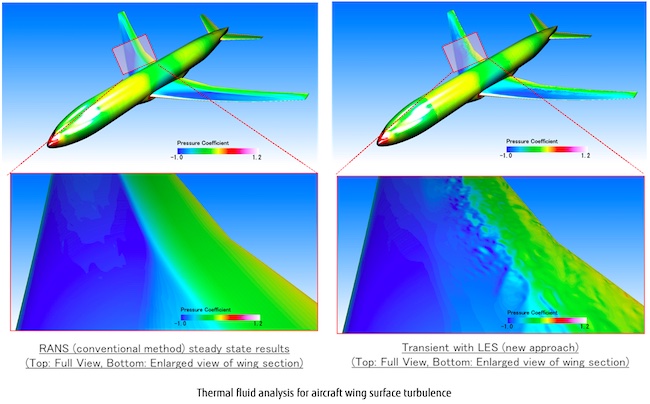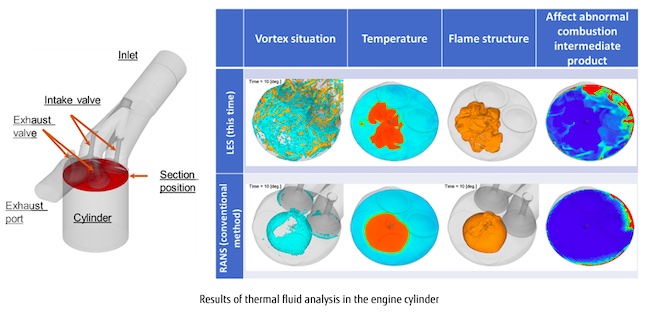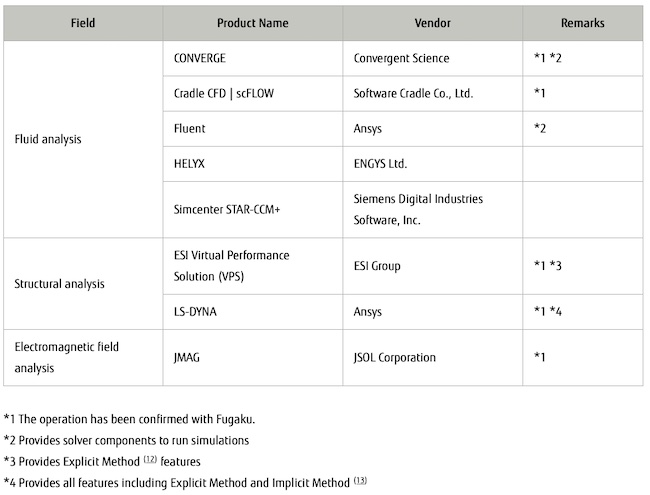TOKYO, June 23, 2021 - (JCN Newswire) - Fujitsu Limited successfully leveraged on the world's fastest supercomputer, Fugaku, to demonstrate the feasibility of high performance, large-scale, very high-definition analyses with commercial applications widely used in the industrial field for simulations including fluid dynamics. The trials were conducted in collaboration with a number of application vendors between November 2020 and May 2021. Fujitsu and the participating vendors have additionally collaborated to validate operations and conduct performance tuning for commercial applications in high demand with manufacturers for Fugaku as well as the Fujitsu Supercomputer PRIMEHPC series, which draws on technology developed for the Fugaku project. Application vendors will begin to offer these commercial applications starting in June 2021.
 |
 |
 |
Going forward, Fujitsu will continue to validate commercial applications using its PRIMEHPC series and will market these to manufacturers and other companies engaged in product development and technical research, contributing to the development of the industrial field as a whole.
Background
Recently, companies in areas including the manufacturing industry increasingly rely on commercial applications for x86 cluster systems (1) to perform simulations including fluid dynamics and structural analysis in product development and technical research. However, the growing demand for increasingly complex simulations presents challenges for users requiring rapid calculation results. The availability of these kinds of commercial applications used as is on supercomputers like Fugaku and Fujitsu's PRIMEHPC series, which boast large-scale, high-speed computing capabilities, could offer many potential benefits by allowing companies to continue using already-familiar applications and make use of their industry and process-specific expertise.
To expedite the availability of these kinds of commercial applications, Fujitsu has provided a number of application vendors with development environments and testing environments for the PRIMEHPC series, working alongside these vendors. In large-scale simulations, Fujitsu analyzed the performance of commercial applications, did performance tuning to eliminate bottlenecks and applied parallel processing technology so that they could run efficiently with highly parallel processing. As a result, Fujitsu has successfully verified the operation of eight commercial applications. Fugaku was used for three of these applications to obtain high-speed, high-definition simulation results for large-scale analysis.
Verification and results of large-scale analysis using commercial applications
In collaboration with various vendors, Fujitsu conducted a large-scale, high definition simulation for improving the energy efficiency and safety of aircraft and automobiles, which represents an increasingly important priority from the viewpoint of reducing environmental impact making use of commercial applications that have been tested for the PRIMEHPC series. Using the computing resources of Fugaku (2), Fujitsu conducted simulations with highly parallel processing, validating the feasibility of performing analyses within the amount of time required by companies for practical application in the real-world.
1. Improvement of aircraft safety
During flight, an aircraft may experience a vibration phenomenon called buffet, which affects its safety and flight stability. Predicting buffet vibration is an important issue for aircraft safety design. This time, by executing the thermal fluid analysis application Cradle CFD | scFLOW (3) in parallel using the maximum possible 192,000 out of Fugaku's total number of CPU cores (4) of Fugaku and analyzing a high-definition model of 237 million elements with LES (5), which is an analysis method capable of expressing fine vortexes, it was possible to observe a phenomenon whereby pressure vibration and fine vortexes are generated on the surface of the blade. This makes it possible to predict the buffet effect in greater detail than the conventional RANS (6) analysis method using a coarse calculation grid. This proved that large-scale analyses leading to the safe design of aircraft taking into account the buffet could be calculated.
2. Improvement of energy efficiency of automobile engines
Improving the energy efficiency of engines is an important issue for improving the fuel efficiency and environmental performance of automobiles. A combustion analysis that takes into account a series of chemical reactions, such as combustion inside a cylinder caused by piston action in the engine, was performed in two hours with parallel calculation using the thermal fluid analysis application CONVERGE (7) using up to 4,620 CPU cores of Fugaku's cores. In this analysis, the entire region was divided by a high-precision calculation grid (up to 6.67 million grids) of 0.5 mm units, and the use of LES made it possible to successfully obtain high-precision results showing a wrinkled flame structure, which would prove difficult with conventional RANS analysis. As a result, highly accurate analysis can be performed even during the limited time required for design work in the manufacturing industry, which is expected to lead to improvements in engine energy efficiency and reductions in abnormal combustion.
3. Reduction of energy loss in driving motors for electric vehicles
To improve the energy efficiency of electric and hybrid vehicles, it is necessary to reduce energy loss in the driving motor. One of the methods to calculate the loss generated by IPM motors (8) used in electric vehicles, etc., with high accuracy is to model the steel sheet of the iron core constituting the motor one by one, and to use the method to input the current containing harmonics. Conventional x86 clusters require several weeks to complete the calculation, but using Fugaku's 8,192 CPU cores and running them in parallel in the electromagnetic field analysis application JMAG (9), it can be done in a day (10). As a result, it is expected that analysis leading to improved energy efficiency in electric vehicles can be performed in a shorter time.
Commercial applications to be verified operations on Fugaku and PRIMEHPC FX1000
By providing vendors with development environments and technical support for Fugaku and PRIMEHPC FX1000, Fujitsu and application vendors have collaborated to newly validate operations for eight commercial applications, beginning with the structural analysis application LS-DYNA from Ansys (11), which is widely used in the manufacturing industry to improve collision safety for automobiles. Application vendors will begin to offer these commercial applications starting in June 2021.
Future Plans
Fujitsu will continue to validate the operation of commercial applications for the PRIMEHPC series to meet the unique, real-world demands of its customers across a variety of industries, including manufacturers and other companies engaged in product development and technical research that want to conduct large-scale, high-definition simulations. Leveraging its industry-leading capabilities in high performance computing and its applications, Fujitsu will continue to contribute to the active development and innovation of technology development and research.
Comments from Mr. Makoto Shibahara, President of Software Cradle Co., Ltd.
Thanks to the efforts of Fujitsu Limited, we have confirmed that our thermal fluid analysis software can be used on the supercomputer Fugaku through this verification. Cradle CFD has been used in a wide range of industries for nearly 40 years, demonstrating the importance of large-scale computing resources in the field of thermo-fluid analysis, and this validation is a major milestone for us. This verification marks a major milestone in the field of thermal fluid analysis, and we believe that the use of Fugaku and our products will enable us to challenge the world's leading supercomputers, which were previously thought to be impossible. As part of the Hexagon Manufacturing Intelligence Group's efforts, we plan to offer Cradle CFD to the general public for use with Fugaku and Fugaku equivalent computing environments.
Comments from Siddharth Shah, Principal Product Manager, Ansys
Ansys is excited to announce the support of LS-DYNA for Fugaku and PRIMEHPC series hardware. LS-DYNA is widely used for its multi-physics capabilities including crash simulations which often requires high computational power. Ansys looks forward to working in close cooperation with Fujitsu to bring to market LS-DYNA for the PRIMEHPC series. Ansys is working to bring other flagship technologies such as Fluent to support Fujitsu PRIMEHPC series in the near future.
(1) x86 cluster systems:
A computer system configuration that connects multiple x86 servers for parallel processing.
(2) Using the computing resources of Fugaku:
This research was carried out by receiving the computational resources of the supercomputer Fugaku of RIKEN through the HPCI System Utilization Research Project (Issue No.: hp200209, hp200302).
(3) Cradle CFD | scFLOW:
Thermal fluid analysis software developed by Software Cradle Co., Ltd.
https://www.cradle-cfd.com/product/scflow.html
(4) CPU Cores:
The Fugaku and PRIMEHPC series have 48 CPU cores of operation per node (1 CPU).
(5) LES:
Abbreviation for Large Eddy Simulation. A method of fluid analysis. It is possible to calculate even a fine vortex structure, but it requires a fine computational cells to express a fine vortex structure, and the calculation time is long.
(6) RANS:
Abbreviation for Reynolds-averaged Navier -- Stokes equations. A method of fluid analysis. This is a method commonly used in the industrial world because even a rough grid can be calculated and the calculation time can be shortened, but it cannot express complicated phenomena such as fine vortices.
(7) CONVERGE:
Thermal fluid analysis software developed by Convergent Science. The distributor in East Asia is IDAJ Co., Ltd.
https://convergecfd.com/
(8) IPM Motors:
Embedded structure permanent magnet (Interior Permanent Magnet) synchronous motor.
(9) JMAG:
Electromagnetic field analysis software developed by JSOL Corporation for the design and development of electrical equipment.
https://www.jmag-international.com/
(10) Done in a day:
Previously, it took several weeks to perform the calculation in 100 parallel, which is often performed in the industry, but it was shortened to one day by 8,192 parallel calculations using Fugaku. Note that 8,192 parallelism exceeds the maximum number of parallelism that has been calculated in JMAG.
(11) LS-DYNA from Ansys:
A structural analysis software developed by Ansys. The system has been provided to some customers in advance for PRIMEHPC FX1000, and operation verification was also conducted for Fugaku. General availability will begin from June.
https://www.ansys.com/products/structures/ansys-ls-dyna
(12) Explicit Method:
An analysis method that directly (explicitly) solves equations that represent the motion of an object. It is suitable for problems in which large deformation and destruction occur instantaneously and is widely used in the manufacturing industry for uses cases including crash analysis of automobiles and fall analysis of electronic devices.
(13) Implicit Method:
An analysis method that indirectly (implicit) solves equations that represent the motion of an object. It is suitable for problems in stamping simulation or strength of static structures like a building, etc.
Fujitsu's Commitment to the Sustainable Development Goals (SDGs)
The Sustainable Development Goals (SDGs) adopted by the United Nations in 2015 represent a set of common goals to be achieved worldwide by 2030. Fujitsu's purpose -- "to make the world more sustainable by building trust in society through innovation"--is a promise to contribute to the vision of a better future empowered by the SDGs.
About Fujitsu
Fujitsu is the leading Japanese information and communication technology (ICT) company offering a full range of technology products, solutions and services. Approximately 126,000 Fujitsu people support customers in more than 100 countries. We use our experience and the power of ICT to shape the future of society with our customers. Fujitsu Limited (TSE:6702) reported consolidated revenues of 3.6 trillion yen (US$34 billion) for the fiscal year ended March 31, 2021. For more information, please see www.fujitsu.com.
Source: Fujitsu Ltd
Copyright 2021 JCN Newswire . All rights reserved.